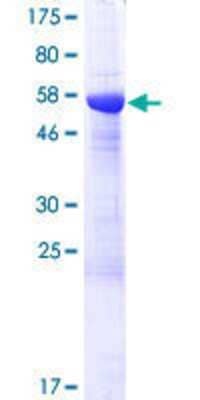Recombinant Human STARD10 GST (N-Term) Protein
Novus Biologicals, part of Bio-Techne | Catalog # H00010809-P01

Key Product Details
Source
Tag
Conjugate
Applications
Product Specifications
Description
Source: Wheat Germ (in vitro)
Amino Acid Sequence: MEKLAASTEPQGPRPVLGRESVQVPDDQDFRSFRSECEAEVGWNLTYSRAGVSVWVQAVEMDRTLHKIKCRMECCDVPAETLYDVLHDIEYRKKWDSNVIETFDIARLTVNADVGYYSWRCPKPLKNRDVITLRSWLPMGADYIIMNYSVKHPKYPPRKDLVRAVSIQTGYLIQSTGPKSCVITYLAQVDPKGSLPKWVVNKSSQFLAPKAMKKMYKACLKYPEWKQKHLPHFKPWLHPEQSPLPSLALSELSVQHADSLENIDESAVAESREERMGGAGGEGSDDDTSLT
Purity
Predicted Molecular Mass
Disclaimer note: The observed molecular weight of the protein may vary from the listed predicted molecular weight due to post translational modifications, post translation cleavages, relative charges, and other experimental factors.
Activity
Protein / Peptide Type
Scientific Data Images for Recombinant Human STARD10 GST (N-Term) Protein
Formulation, Preparation and Storage
H00010809-P01
| Preparation Method | in vitro wheat germ expression system |
| Formulation | 50 mM Tris-HCl, 10 mM reduced Glutathione, pH 8.0 in the elution buffer. |
| Preservative | No Preservative |
| Concentration | Please see the vial label for concentration. If unlisted please contact technical services. |
| Shipping | The product is shipped with dry ice or equivalent. Upon receipt, store it immediately at the temperature recommended below. |
| Stability & Storage | Store at -80C. Avoid freeze-thaw cycles. |
Background: STARD10
STARD10 is broadly expressed in different organs and tissues such as the brain, endocrine tissues, liver, and gastrointestinal tract. STARD10 is regulated by Casein kinase II, which phosphorylates STARD10 at serine 284 leading to decreased lipid transfer activity and reduced membrane association. STARD10 is overexpressed in breast carcinoma cell lines and in primary breast cancers (3). STARD10 has been implicated in the regulation of bile acid homeostasis and more recently in the regulation of insulin secretion from beta-cells (1, 2, 4).
References
1. Alpy, F., & Tomasetto, C. (2005). Give lipids a START: The StAR-related lipid transfer (START) domain in mammals. Journal of Cell Science. https://doi.org/10.1242/jcs.02485
2. Alpy, F., Legueux, F., Tomasetto, C., & Bianchetti, L. (2009). START domain-containing proteins: A review of their role in lipid transport and exchange. Medecine/Sciences. https://doi.org/10.1051/medsci/2009252181
3. Olayioye, M. A., Hoffmann, P., Pomorski, T., Armes, J., Simpson, R. J., Kemp, B. E., ... Visvader, J. E. (2004). The phosphoprotein StarD10 is overexpressed in breast cancer and cooperates with ErbB receptors in cellular transformation. Cancer Research. https://doi.org/10.1158/0008-5472.CAN-03-3731
4. Carrat, G. R., Hu, M., Nguyen-Tu, M. S., Chabosseau, P., Gaulton, K. J., van de Bunt, M., ... Rutter, G. A. (2017). Decreased STARD10 Expression Is Associated with Defective Insulin Secretion in Humans and Mice. American Journal of Human Genetics. https://doi.org/10.1016/j.ajhg.2017.01.011
Long Name
Alternate Names
Gene Symbol
Additional STARD10 Products
Product Documents for Recombinant Human STARD10 GST (N-Term) Protein
Product Specific Notices for Recombinant Human STARD10 GST (N-Term) Protein
This product is produced by and distributed for Abnova, a company based in Taiwan.
This product is for research use only and is not approved for use in humans or in clinical diagnosis. This product is guaranteed for 1 year from date of receipt.
